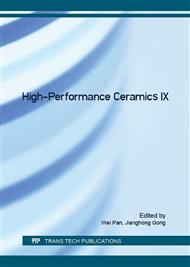p.203
p.207
p.211
p.219
p.223
p.227
p.231
p.235
p.239
Evidence of Normal to Anti Ferroelectric Phase Transition of PLZT Transparent Ceramics of Different Zr/Ti Ratio
Abstract:
The lanthanum-modified lead zirconate titanate transparent ceramics with different Zr/Ti ratio were prepared by the hot pressing sintering method. A single perovskive structure with a dense microsctructure was obtained and the transgranular fracture of PLZT ceramics tended to be more serious As the Zr/Ti ratio increases, the transmittance of PLZT ceramics tended to be higher and the transgranular fracture became more serious. The P-E loops changed froe a square hysteresis loop to a double tending slim hysteresis loop. Besides,the S-E loops changed from a approximate parabolic shape to a butterfly shape. These two loops confirm the transition from normal ferroelectric to anti ferroelectric phase occured with the Zr/Ti ratio increasing.
Info:
Periodical:
Pages:
223-226
Citation:
Online since:
July 2016
Authors:
Keywords:
Price:
Сopyright:
© 2016 Trans Tech Publications Ltd. All Rights Reserved
Share:
Citation:


